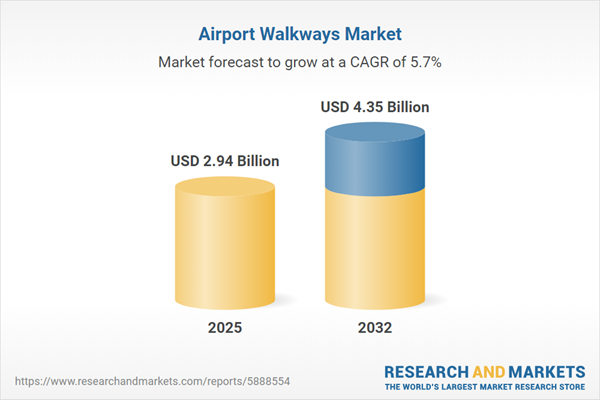Speak directly to the analyst to clarify any post sales queries you may have.
The airport walkways market is reshaping strategies for senior airport leaders, offering new avenues to strengthen terminal operations, adapt to shifting traveler expectations, and maximize return on infrastructure investments. With digital transformation and operational agility in focus, decision-makers are finding critical opportunities to elevate passenger experiences and operational efficiency.
Market Snapshot: Airport Walkways Market Trends and Growth
In 2024, the global airport walkways market reached USD 2.78 billion, propelled by ongoing modernization efforts and a compound annual growth rate (CAGR) of 5.74%. Increased passenger volumes and international air travel have driven airports to adopt advanced mobility solutions. Market providers are focusing on technology-enabled walkways that enhance operational reliability while keeping pace with evolving traveler needs. As passenger flows grow more complex, airports are investing in modular designs and region-specific solutions. The industry’s emphasis on passenger safety, adaptable infrastructure, and compliance with upgraded operational standards is fueling further adoption of intelligent walkway systems in major transport hubs.
Scope & Segmentation of the Airport Walkways Market
This report gives senior airport executives a focused overview of vital priorities and segmentation in the airport walkways market. The analysis addresses critical opportunities to boost efficiency, adaptability, and smart infrastructure investment across the global aviation sector.
- Operation: Tailored walkway systems meet both indoor and outdoor requirements, supporting efficient, climate-ready access between terminals, parking structures, and ancillary facilities.
- Installation Type: Solutions address new builds, expansions, major renovations, and retrofit scenarios, ensuring that walkways remain relevant throughout each terminal’s lifecycle.
- Product Type: Curved, inclined, and straight walkway designs improve space utilization and upgrade user experience in a range of airport environments.
- Drive Type: Systems offer geared, gearless, and hybrid propulsion to meet energy efficiency targets, simplify maintenance, and extend system service life in busy terminals.
- Length: Modular components allow precise tailoring of walkway lengths, from short connectors to long corridors in large or multi-terminal airports.
- End User: While airports are principal users, metro transit facilities and large retail venues are adopting integrated walkways to enhance overall traffic flow and accessibility.
- Geographies Covered: The landscape is shaped by regional differences, including North American design accessibility, European sustainability mandates, and the scale of expansion in Asia-Pacific and Middle East & Africa markets.
- Leading Companies: Notable industry players such as Otis Worldwide Corporation, Schindler Group AG, KONE Corporation, and Mitsubishi Electric Corporation offer end-to-end support, delivering customizable systems aligned with regulatory and operational goals.
Digital technologies are strengthening predictability and resilience. Predictive analytics and online monitoring support maintenance scheduling and minimize unplanned downtime. Customization is also key, with airports in different regions prioritizing varied objectives ranging from sustainability to capacity scaling.
Key Takeaways: Strategic Insights for Senior Decision-Makers
- Integrated walkway solutions streamline transfers within airports, fostering safe, compliant operations that keep passenger journeys efficient as traffic grows.
- Technological upgrades focus on user comfort and convenience by incorporating ergonomic features, optimized lighting, and advanced cleanliness protocols for densely used environments.
- Prefabricated and modular systems accelerate installation timelines in both renovations and new builds, minimizing interruptions to core terminal activities.
- Collaboration across manufacturers, technology vendors, and airport authorities leads to solutions tailored to regional regulations and specific operational targets.
- Sustainability gains come from efficient propulsion systems and use of recycled construction materials, helping to address long-term environmental and fiscal objectives.
- New digital platforms empower airport managers by enabling predictive maintenance and improved responsiveness to shifting travel patterns and operational schedules.
Tariff Impact: Navigating Cost and Supply Chain Challenges
Recent U.S. tariffs on steel and aluminum are prompting airport procurement teams to adjust their cost models and supply chain approaches. To reduce exposure to fluctuating input costs, industry leaders are emphasizing local sourcing, targeted purchasing, and strategic logistics planning. Ongoing monitoring of tariff fluctuations is supporting stable project delivery, risk mitigation, and maximized asset value.
Methodology & Data Sources
Findings are based on direct interviews with sector experts, regulatory reviews, and examination of implemented projects worldwide. Each recommendation uses independently validated data to provide practical direction tailored to the needs of airport leaders.
Why This Report Matters
- Supports senior executives in benchmarking mobility infrastructure strategies and informing long-term capital planning.
- Enables procurement and operations teams to specify future-ready walkway systems that align with evolving regulatory and traveler requirements.
- Assists supply chain specialists in anticipating shifts in market and policy, reducing business risks and maintaining project momentum.
Conclusion
Modern walkway systems have become central to optimizing passenger flow, maintaining operational reliability, and future-proofing airport infrastructure as global travel demands evolve.
Additional Product Information:
- Purchase of this report includes 1 year online access with quarterly updates.
- This report can be updated on request. Please contact our Customer Experience team using the Ask a Question widget on our website.
Table of Contents
3. Executive Summary
4. Market Overview
7. Cumulative Impact of Artificial Intelligence 2025
Companies Mentioned
The companies profiled in this Airport Walkways market report include:- Otis Worldwide Corporation
- Schindler Group AG
- KONE Corporation
- Mitsubishi Electric Corporation
- Fujitec Co., Ltd.
- Hitachi, Ltd.
- Hyundai Elevator Co., Ltd.
- Shanghai Mitsubishi Elevator Co., Ltd.
Table Information
| Report Attribute | Details |
|---|---|
| No. of Pages | 197 |
| Published | October 2025 |
| Forecast Period | 2025 - 2032 |
| Estimated Market Value ( USD | $ 2.94 Billion |
| Forecasted Market Value ( USD | $ 4.35 Billion |
| Compound Annual Growth Rate | 5.7% |
| Regions Covered | Global |
| No. of Companies Mentioned | 9 |









